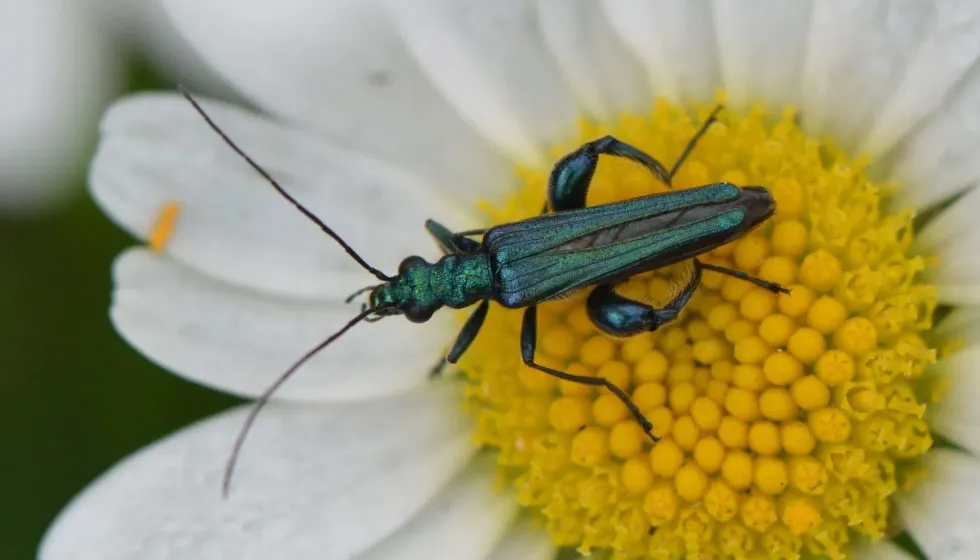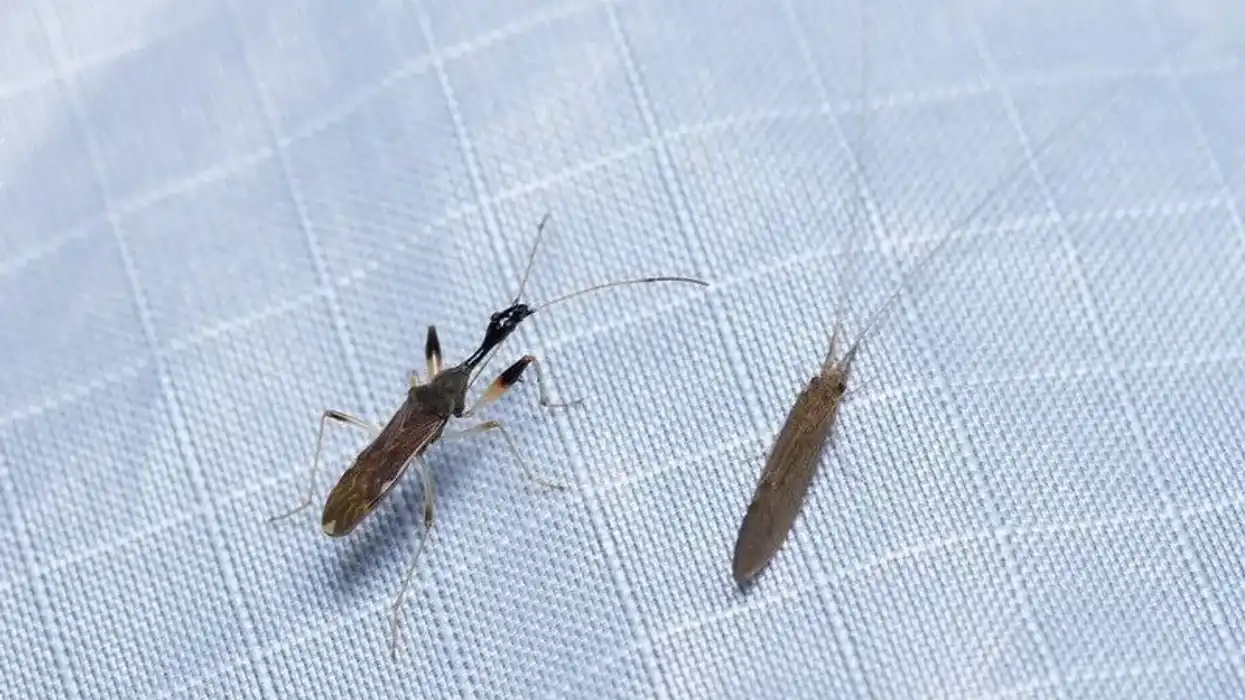In this article, we will learn about the magnificent thick-legged flower beetle. The thick-legged flower beetle (scientific name Oedemera nobilis) is a common beetle found in Western lowland Europe and the Mediterranean.
This beetle is also known as swollen thighed beetle or false oil beetle. These beetles are named so due to the swollen hind legs and femora of the male beetles.
Females, in contrast, have thin femora. The flower beetle, Oedemera nobilis is bright metallic green in color beetle and has hard-shelled elytra. The Elytra (hind wings) of this species of beetle have a separation and do not cover their underwings completely.
These small insects feed on the pollen and the nectar of open flowers like Asteraceae, Rosaceae, Apiaceae, and Cyperaceae. They love the warm weather and the sun so they can easily be spotted hovering around flower heads in the summer season, especially during May to August.
Keep reading to learn more about this striking green metallic insect. To learn more about other species, check out Longhorn Beetle Facts and Golden Tortoise Beetle.
Thick-Legged Flower Beetle Interesting Facts
What type of animal is a thick-legged flower beetle?
Thick-legged flower beetle, as the name suggests is a type of beetle.
What class of animal does a thick-legged flower beetle belong to?
Thick-legged flower beetle belongs to the class Insecta and the family Oedemeridae.
How many thick-legged flower beetles are there in the world?
Thick-legged flower beetles have an extensive range and are found in large numbers, especially in the UK. It, therefore, becomes quite difficult to calculate the total population of Oedemera Nobilis in the world.
Where does a thick-legged flower beetle live?
The thick-legged flower beetle can commonly be found in Western lowland Europe and the Mediterranean. In the past couple of years, their range has also expanded towards Britain.
What is a thick-legged flower beetle's habitat?
The thick-legged flower beetle (Oedemera Nobilis) loves sunshine and warm weather. They can be found in colorful flowers in parks and gardens. These beetles are pollinators of flowers like the bramble, ox-eye daisy, and cow parsley.
Who do thick-legged flower beetles live with?
Most studies point to the fact that these flower beetles live in groups. However, like several species of beetles, they can be solitary as well.
How long does a thick-legged flower beetle live?
The thick-legged flower beetle (Odemera Nobilis) can live up to a year.
How do they reproduce?
After mating, the female thick-legged flower beetle (Oedemera nobilis) lays the eggs in tree barks. The larvae hatch in the dry stems of plants like Cirsium and Spartium.
What is their conservation status?
The thick-legged flower beetle (Oedemera nobilis) is under the Not Listed category, in the International Union for Conservation of Nature or the IUCN Red List. The thick-legged flower beetle does have a stable population and is common in Western Europe.
Thick-Legged Flower Beetle Fun Facts
What do thick-legged flower beetles look like?
The thick-legged flower beetle is sexually dimorphic. The beetle justifies its name and has thick, swollen legs. Male beetles are the only ones that have swollen femora or hind legs. The swollen femora are used while mating.
Females, on the other hand, display thin femora. The thick-legged flower beetle, like most beetles, has hardened forewings known as elytra that are slightly separated as a result of which, the underwings are left exposed. These beetles are striking green in color with a coppery or golden sheen.
How cute are they?
The thick-legged flower beetle has a striking green body with a copper sheen and appears to be quite magnificent.
How do they communicate?
The exact communication patterns of thick-legged flower beetles are not known. Beetles in general are known to communicate with each other through different chemicals. They can also locate each other through their sense of smell.
How big is a thick-legged flower beetle?
A thick-legged flower beetle has a length between 0.3-0.4 in (8-10 mm). These beetles are quite small in size and are about 10 times smaller than elephant beetles.
How fast can thick-legged flower beetles move?
There has not been enough research conducted to calculate the speed of the thick-legged flower beetle (Oedemera nobilis).
How much does a thick-legged flower beetle weigh?
Oedemera nobilis, or the swollen-legged beetle, is very small in size and perhaps that's the reason why not much research has been conducted to calculate its weight.
What are the male and female names of the species?
There are no unique names to identify the male and female thick-legged flower beetle. Males and females, however, are very different from each other in appearance. Males have swollen femora whereas females have very thin femora.
What would you call a baby thick-legged flower beetle?
A baby thick-legged flower beetle can be known as a larva like most insects.
What do they eat?
The thick-legged flower beetle is a pollen-feeding insect. These beetles are a pollinator of many flowers and feed on the pollen and nectar of Asteraceae, Rosaceae, Apiaceae, and most commonly on Ox eye daisy, cow parsley, and bramble.
Are they harmful?
The thick-legged flower beetles are not harmful and do not cause any trouble to humans. They do however contain Cantharidin which acts as a poisonous defense against dangerous predators.
Would they make a good pet?
The thick-legged flower beetle is super small in size and would make an unlikely pet. You may wish to keep these beetles as your pet but it is not advisable. These insects feed on pollen and nectar, so providing them with adequate nutrition would prove to be quite difficult.
Did you know...
The elytra of the thick-legged flower beetle are tapered towards the tip of its abdomen and do not completely cover its wings.
Similar to bees, the thick-legged flower beetle does not just feed on pollen and nectar but also transfers the pollen between the different flowers.
The thick-legged flower beetle (Oedemera nobilis) bears a close resemblance to Odemera flavipes and it can often be confusing to differentiate between the two. However, the thick-legged flower beetle is green in color and has a long white pubescence in contrast to the Oedemera flavipes which is dark greenish-grey in color.
Naming the thick-legged flower beetle
The thick-legged flower beetle has been aptly named. Male beetles have swollen hind legs or femora and can be found hovering around flower heads, feeding on their nectar and pollen. Thick-legged flower beetles are also known as false-oil beetles or swollen thighed beetles.
Identifying British beetles
Beetles are very common in the UK, with over 4,000 beetle species present in the British Isles. Beetles make up about 40% of the total insect species in the UK. Some of the most common beetles in the UK are the following: the green tiger beetle, twenty-two spot ladybird, oil beetle, and stag beetle.
The green tiger beetle: this beetle can easily be identified by its bright green color, sharp jaws, and long legs.
Twenty-two spot ladybird: As the name suggests, this beetle is vibrant yellow and has exactly 22 black spots on its wings.
Oil beetle: this beetle is very common in the UK. They are named the oil beetle due to the oily sheen on their body.
Stag beetle: this is the largest beetle found in the UK. Male stag beetles have enlarged jaws which makes them appear to be quite scary.
Here at Kidadl, we have carefully created lots of interesting family-friendly animal facts for everyone to discover! Learn more about some other arthropods including Eastern Hercules Beetle Facts, and Ten-Lined Fune Beetle Facts.
You can even occupy yourself at home by drawing one on our Thick-Legged Flower Beetle coloring pages.









